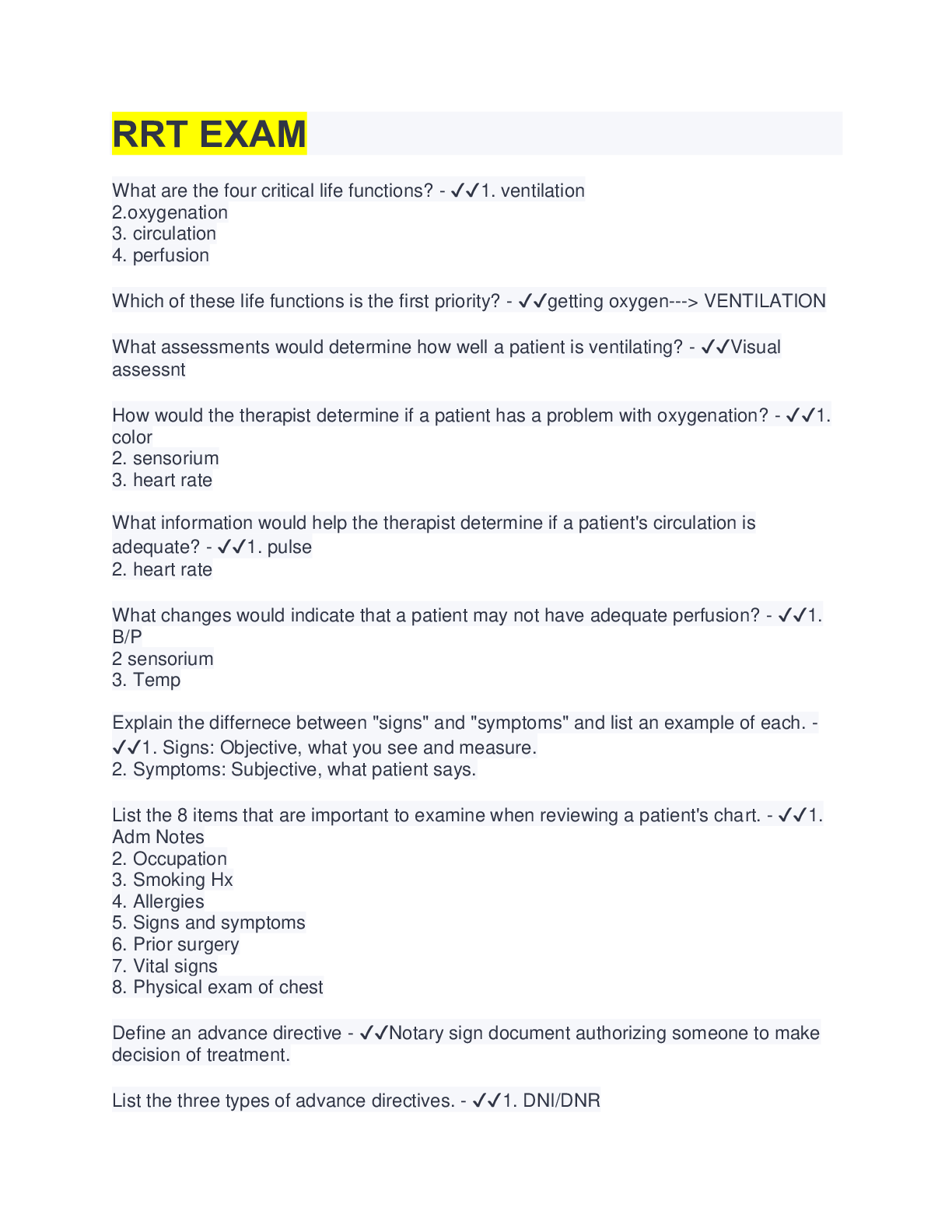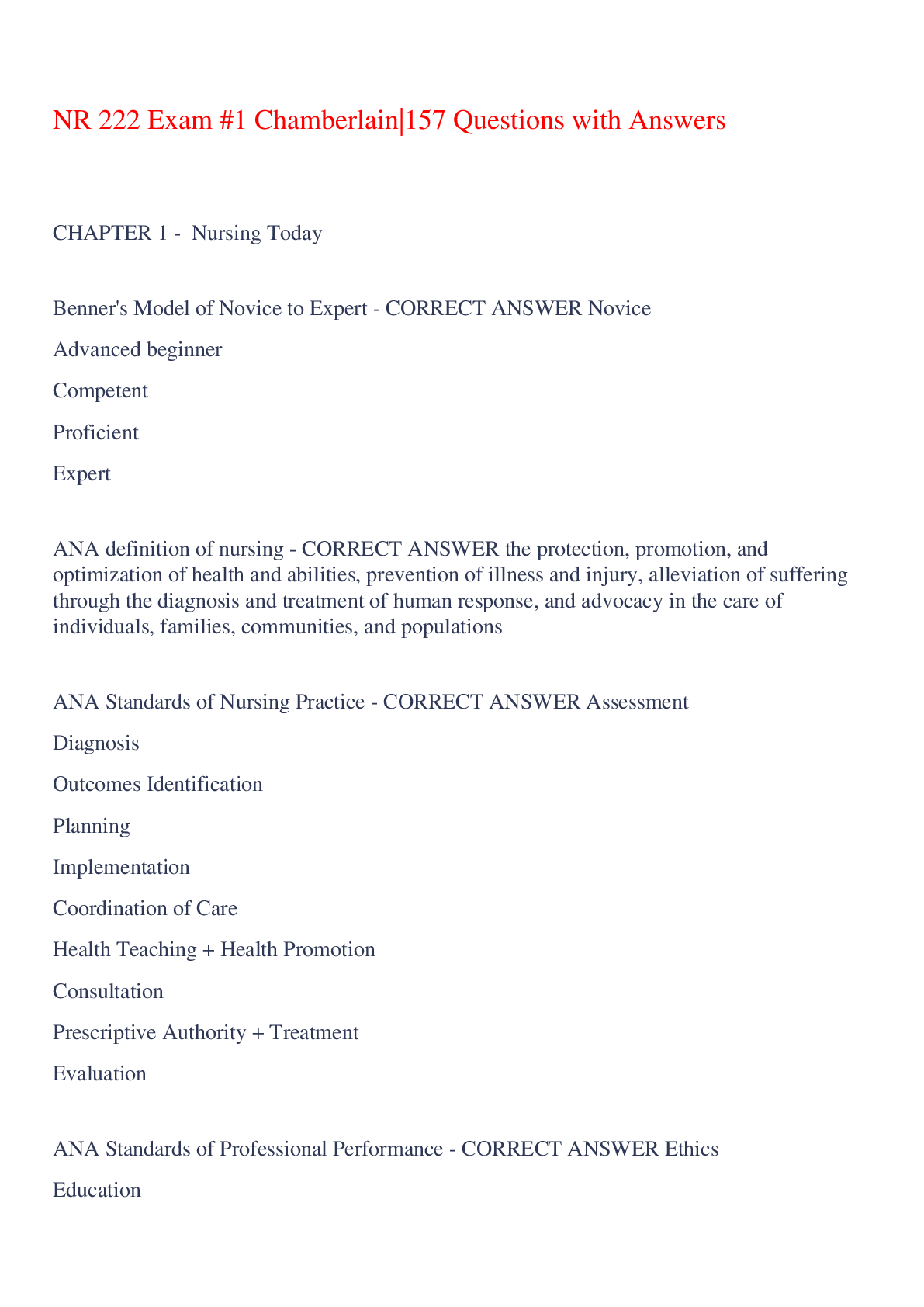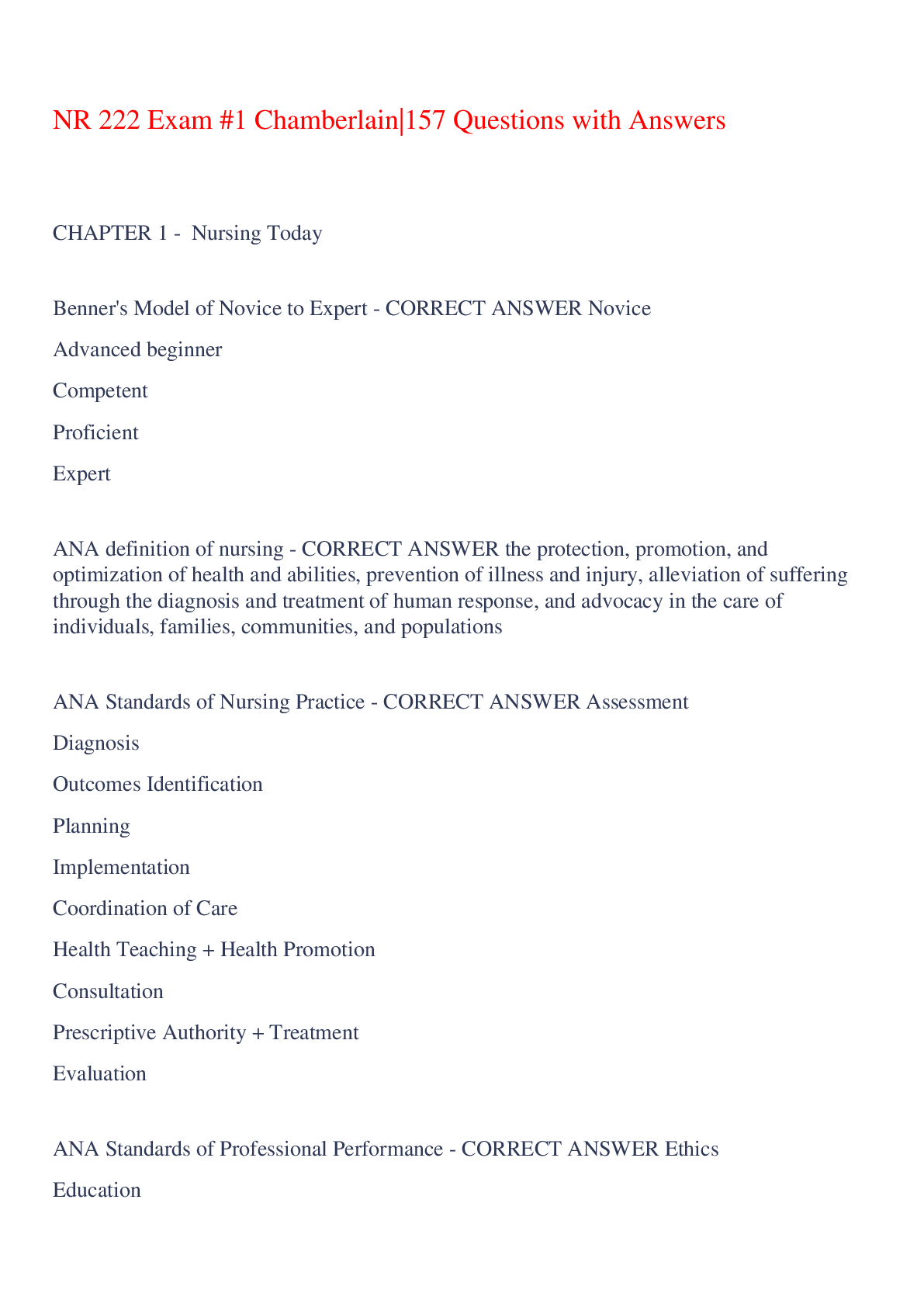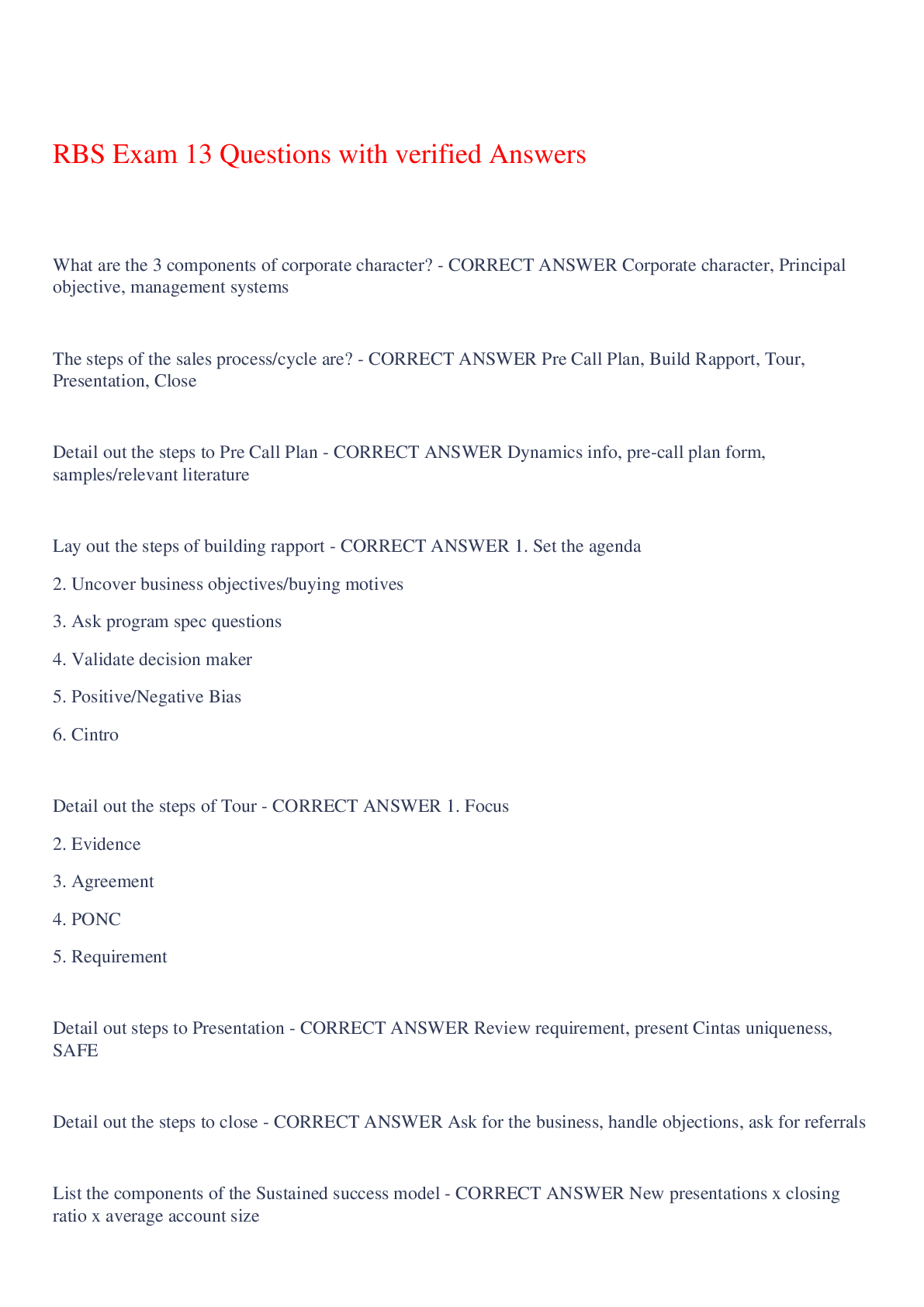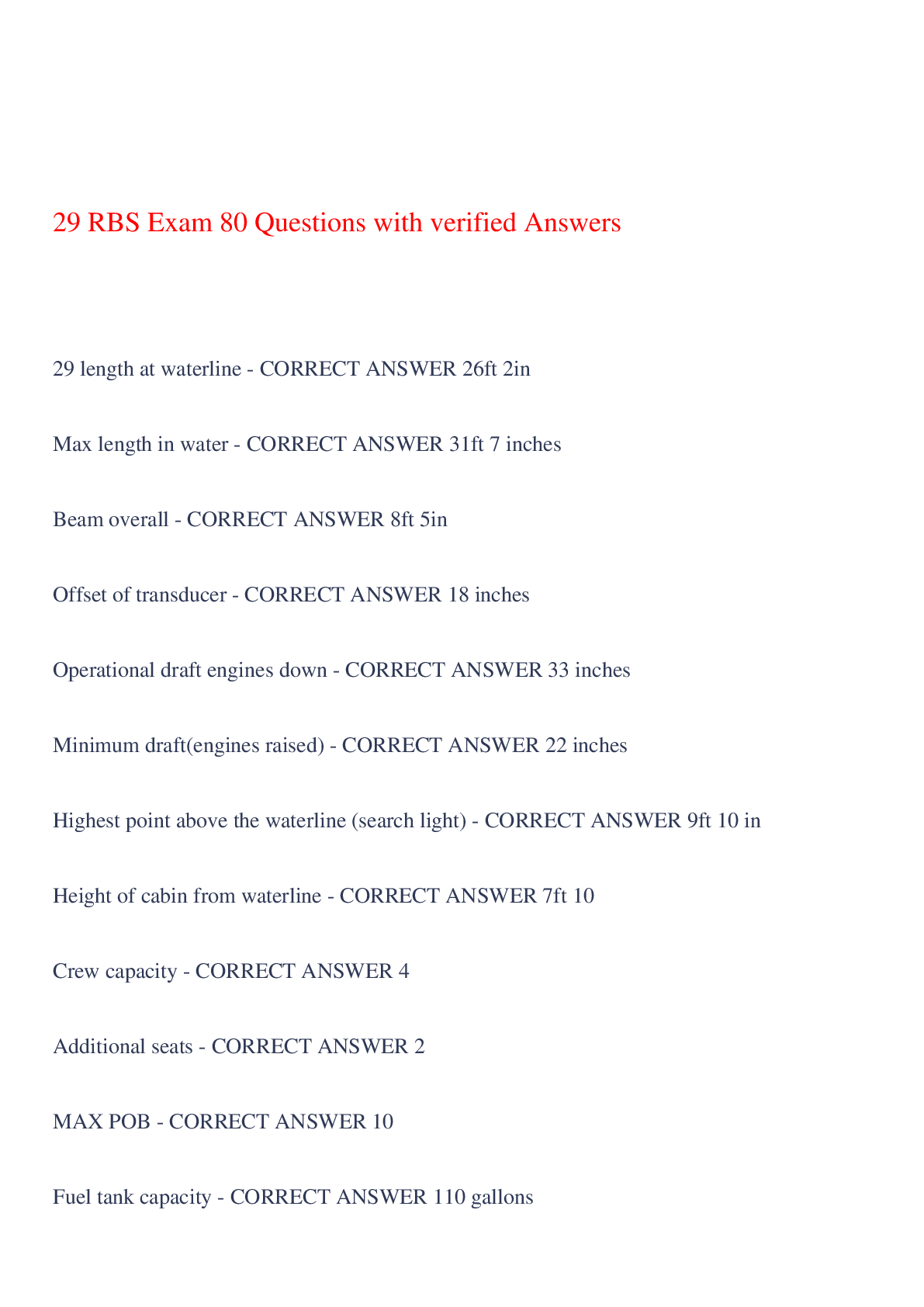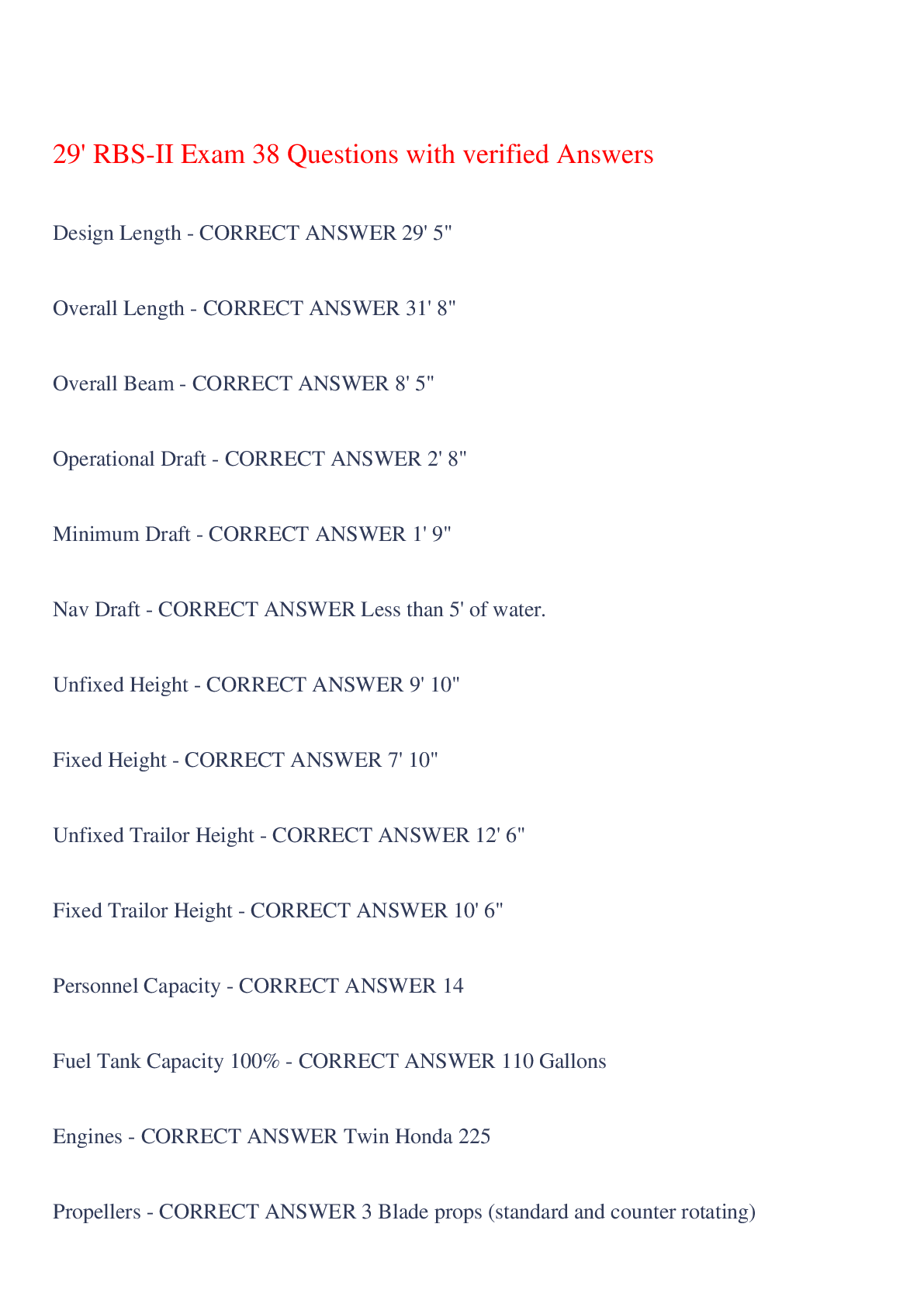CNRN Exam 157 Questions with Verified Answers,100% CORRECT
Document Content and Description Below
CNRN Exam 157 Questions with Verified Answers Glascow Coma Scale (GCS) - CORRECT ANSWER Used to assess/classify level of consciousness particularly in acute stages of injury or comatose patients. T... he scale ranges from 3-15. Score 13-15=mild injury. Score 9-12=moderate injury. Score less than 8=severe brain injury. If patient is unresponsive to auditory cues, tactile stimulation is applied. Begin with gentle touching or gentle shaking, if no response, more pressure or pinching to the upper chest or upper back is applied. Responses include body or limb withdrawal, or pushing the examiner away. GCS score 13-15 - CORRECT ANSWER Mild injury GCS score 9-12 - CORRECT ANSWER Moderate injury GCS score less than 8 - CORRECT ANSWER Severe brain injury Level of Consciousness (LOC) - CORRECT ANSWER Major indicator of neurological change. Consciousness refers to both alertness and cognitive function. The Glascow coma score is most commonly used to numerically rank LOC, but qualitative descriptions are also helpful. Confused patients are disoriented and may have memory deficits. Lethargic patients demonstrate some confusion and slowed responsiveness. Patients in obtundation require stimulation. Stupor is lack of spontaneous movement, or verbalization, and minimal responsiveness. Coma is divided into 3 levels based on response to painful stimuli. Patients in coma are unarousable and have their eyes closed. Complete unresponsiveness=deep coma. Light coma=withdrawal from painful stimuli and brainstem reflexes are intact. Secondary cellular injury - CORRECT ANSWER Primary injury induces damaging secondary processes including ischemia, hypoxia, and secondary axotomy, which activate additional cellular reactions that further perpetuate injury. Injurious cellular cascades include excitotoxicity, which begins with the release of high concentrations of the excitatory neurotransmitters glutamate and aspartate from axotomized or degenerating neurons. Excessive activation of their receptors leads to abnormal influx of calcium ions, which activate intracellular biochemical signaling cascades that lead to cell death. An influx of sodium ions also carries water into the cell causing swelling. Traumatic Brain Injury - CORRECT ANSWER Primary injury is insult caused by direct contact to the head and brain at the time of injury. Low velocity impact limits injury to the scalp (laceration) or skull (fracture), whereas high velocity impacts the brain as well (intracerebral hemorrhage). Primary injury induces damaging secondary events: - CORRECT ANSWER Including intracranial hemorrhage, cerebral edema, and increased intracranial pressure. Brain swelling or intracrainal hematoma can increase intracranial pressure, increasing liklihood of mass effect and herniation. Secondary injuries are generally considered to develop four hours or more later than the initial injury, and a major goal of primary care is to minimize their occurrence. Traumatic cerebral injury - CORRECT ANSWER Classifications: Focal-cerebral contusions, lacerations, and intracranial hemorrhage. Diffuse-concussion and diffuse axonal injury (DAI) Penetrating-usually gunshot contusion and laceration-focal TBI - CORRECT ANSWER terms used to describe visible bruising and tearing of cerebral tissue arachnoid remains intact Mild concussion is characterized by: - CORRECT ANSWER headache, confusion, or gait disturbances NO LOC classic concussion - CORRECT ANSWER Brief loss of consciousness. Amnesia, Headache, and other neuro symptoms more pronounced. Warn patient and family to report deterioration in neurological status. Shearing force causes microscopic axonal and blood vessel tearing along susceptable junctions, leafing to diffuse axonal injury (DAI). Diffuse Axonal Injury (DAI) - CORRECT ANSWER Widespread disruption of axons due to acceleration or deceleration injury. Small, petechial hemorrhages at gray-white junction of cerebral hemispheres and or corpus callosum. Management of patients with severe traumatic brain injury: - CORRECT ANSWER Initial management of patients with severe traumatic brain injury follows the same principles as for spinal cord injury. Primary concerns are for airway patency, respiration, respiration, circulation, and level of consciousness. Emergency department care is focused on stabilization and minimize secondary injury. Monitoring intracranial pressure, oxygen supply, and additional systemic problems continue in the ICU. Ventriculostomy is useful to drain cerebral spinal fluid and lower intracrainial pressure. Sedation can reduce complications from agitation, ventilator asynchrony, and elevated oxygen demand. Drug treatments should take into account potential effects on cerebral blood flow and oxygen metabolism. Euvolemia maintained with hypertonic saline solution regulates intracrainial pressure and blood pressure. Stool softeners prevent constipation to reduce risk of elevated intracranial pressure. Euvolemia - CORRECT ANSWER state of normal body fluid volume hypertonic solution - CORRECT ANSWER A solution in which the concentration of solutes is greater than that of the cell that resides in the solution Treatments for Traumatic Brain Injury - CORRECT ANSWER Noncontrast CTs are useful for identifying (or ruling out) blood accumulation associated with hemorrhage and hematoma, as well as cerebral edema and anoxia. Small hematomas may reabsorb, but larger hematomas, intraventricular and subarachnoid hemorrhages may require surgery. Surgery may not improve the outcome of intracerebral hemorrhage, suppotrting the importance of supportive care. Penertrating gunshot wounds are generally addressed surgically to remove bone and bullet fragments and evacuate hematomas. Diffuse axonal injury is associated with unconsciousness, but trauma is sometimes not evident at the resolution of the CT scan. Increased intracranial pressure is an issue with each of these conditions. Observation is generally the approach to concussion. Contusions and lacerations of the skin require wound care, and skull fractures may necessitate reconstructive surgery. Multisystem management of traumatic brain injury - CORRECT ANSWER Traumatic Brain Injury produces a range of complications in various bodily systems. Assuring respiratory or ventilator function and airway patency are critical. Positioning the patient on their side facilitates drainage, and suctioning clears the airway. Atelectasis, or reduced functional lung volume, can be prevented with chest physical therapy or deep breathing exercises which can also prevent aspiration and pneumonia. Cardiovascular function should be monitored for cardiac arrhythmias and to maintain appropriate blood pressure. Immobility leads to DVT and PE. Elastic stockings, compression boots and heparin may help prevent clot formation. Antacids or other drugs may be used to control gastric pH thereby preventing irritation, ulcers, and GI hemorrhage. Use of higher saline concentrations for fluid replacements for fluid replacement can help prevent hyponatremia which can lead to seizure or coma. Hyperglycemia should be prevented with insulin, as it may worsen ischemic injury. Nutritional needs should be assessed by a dietician and addressed as soon as possible with a feeding tube inserted in the jejunum. Primary headaches - CORRECT ANSWER migraine, tension, cluster, and chronic daily headaches Chronic daily headache CDH - CORRECT ANSWER Headaches that occur ≥ 15 days per month for at least 3 months Two types of CDH: 1. HAs lasting longer than 4 hours (including chronic or transformed migraine, chronic tension-type headache, and hemicrania continua) 2. HAs lasting less than 4 hours duration, including cluster headache, chronic paroxysmal hemicrania, and short-lasting unilateral neuralgiform headache attacks with conjunctival injection and tearing. neurogenic pain - CORRECT ANSWER Chronic pain caused by nerve damage. Nerve damage caused by spinal cord tumors, spinal stenosis, trauma, nerve entrapment such as carpal tunnel. Complex Regional Pain Syndrome (CRPS) - CORRECT ANSWER Complex regional pain syndrome is an uncommon form of chronic pain that usually affects an arm or leg. Complex regional pain syndrome typically develops after an injury, phantom pain after amputation, surgery, stroke or heart attack, but the pain is out of proportion to the severity of the initial injury, if any. Tx's: - Apply heat and cold: to relieve swelling and sweating. - Topical Analgesics: Creams - PT: Gentle guided ex's to decrease pain and increase ROM and STR. - TENS (nerve stimulation) : Electrical impulses to nerve endings - Biofeedback or Spinal cord stimulation rhizotomy - CORRECT ANSWER destroys the dorsal sensory nerve root, therby removing all sensation cordotomy (chordotomy) - CORRECT ANSWER procedure which interferes with pathways within the spinal cord that control pain produces extensive unilateral analgesia by lesioning the spinothalamic tract peripheral neuropathy - CORRECT ANSWER chronic sensations of pain-tingling, numbness, or other dysesthesias in the periphery, often the hands or feet dysesthesia - CORRECT ANSWER painful sensation Causes of peripheral neuropathy - CORRECT ANSWER Primary cause-Demyelination Diabetes, HIV, and peripheral nerve trauma are all predisposing factors, and increasing age. Peripheral neuropathy may lead to - CORRECT ANSWER Weakness, loss of sensation, difficulty walking, using hands-may need a supportive brace Increased risk for falls Pain is an ongoing concern-primarily managed with pharmacologically Exercise, physical therapy, and proper nutrition can slow functional decline and also help alleviate pain. A patient has been admitted to the hospital for status epilepticus. The patient is currently postictal. Which of the following is the most important nursing consideration for managing the patient? - CORRECT ANSWER Maintain the airway A young child is bought into the hospital for recurrent staring episodes while at school. What is the likely etiology for her symptoms? - CORRECT ANSWER Petit mal seizure An 85 year old woman presents to the emergency department with facial droop, dysarthria(slurred speech), and unilateral weakness that started 6 hours prior to arrival. Her medical history includes HTN, and gallbladder surgery last week. Her blood pressure is 165/85. Which of the following is contraindication for administering tissue plasminogen activator (tPA)? - CORRECT ANSWER Symptom onset Absolute contraindications to tPA - CORRECT ANSWER Within 4.5 hours of stroke symptoms, intracranial hemorrhage, recent head trauma in last 3 months, active internal bleeding, uncontrolled blood pressure (more than 185/100), abnormal clotting factors due to malignancy or anticoagulation (INR more than 1.7, platelet count less than 100,000/mm), glucose less than 50 or more than 400, and seizure at stroke onset. A patient has an external ventricular drain. The intracranial pressure (ICP) ranges from 25-30 mm Hg. Which of the following signs/symptoms would NOT be consistent with these ICPs? - CORRECT ANSWER Tachycardia What nutritional advice is best for a patient who will be discharged at home on warfain (coumadin) to prevent recurrence of embolic stroke? - CORRECT ANSWER Green leafy vegetables are OK in moderation. What is the best dietary advice to give a patient diagnosed with myasthenia gravis? - CORRECT ANSWER Eat 6 small meals a day Which of the following is the most accurate diagnostic test for Chiari Malformation? - CORRECT ANSWER MRI Which position is a patient advised to maintain to minimize symptoms following a lumbar puncture? - CORRECT ANSWER Prone A patient with an external ventricular drain (EVD) has an ICP of 30mmHg. The output of the drain is very sluggish when it is opened. What is the next step? - CORRECT ANSWER Call the attending resident A patient's Tinetti score is 19 prior to a lumbar puncture. After the lumbar puncture, the Tinetti score improves to 28. What is the most likely diagnosis? - CORRECT ANSWER Normal pressure hydrocephalus A patient had a stroke involving the limbic system. What type of deficit is most likely to result? - CORRECT ANSWER Flat affect A patient who has had a stroke is going to be discharged with aspirin (Ecotrin) and ticagrelor (Brilinta). Which of the following side effects of these medications should the family be educated about? - CORRECT ANSWER Bleeding All of the following methods are used to decrease intracranial pressure EXCEPT: - CORRECT ANSWER hyPOtonic intravenous fluids Which of the following interventions would likely be needed in a patient with end-stage Creutzfeldt-Jakob disease? - CORRECT ANSWER Percutaneous endoscopic gastrotomy (PEG) tube The nurse assessing the motor function of an unconscious patient. Which of the following can be used to test the patient's peripherial response to pain? - CORRECT ANSWER Applying nailbed pressure A nurse treating a patient with pneumococcal meningittis. Which of the following are the most important measures to prevent the spread of disease? - CORRECT ANSWER Face mask, gown, and gloves A patient suddenly develops extremity tremors, drooling and eye-rolling. The episode resolves spontaneously and afterward the patient is confused and lethargic. What type of seizure did this patient most likely experience? - CORRECT ANSWER Grand mal seizure An incarcerated patient with a history of HIV develops lethargy, anorexia, vomiting, and high-grade fever. On physical exam the patient has a positive Brudzinski sign. Which if the following tests would not be used to confirm the diagnosis? - CORRECT ANSWER CT of the abdomen and pelvis What is the common primary brain tumor in American Adults? - CORRECT ANSWER Glioblastoma multiforme A 71 year old man is involved in a car accident He denies complaints but undergoes a MRI of the brain, which reveals a 3 mm meningioma. What is the best course of initial treatment? - CORRECT ANSWER Follow-up imaging of the brain A patient is diagnosed with a malignant lesion in the frontal cortex. Which of the following is most likely to be affected? - CORRECT ANSWER Behavior inhibition Which medication is the first-line therapy in treating absence seizures? - CORRECT ANSWER Ethosuximide (Zarontin) A 44 year old woman arrives in the emergency room after being involved in a high speed MVA. A CT scan of the head reveals a convex hypodensity in the right parietal cortex. What is the most likely diagnosis? - CORRECT ANSWER Epidural hematoma A patient's spouse post hemicraniectomy is being discharged to a rehabilitation center. The patient's spouse asks how often he should be wearing his crainiectomy helmet. What is the most appropriate response? - CORRECT ANSWER He should only wear it when he is out of bed. A patient with an EVD has developed a steadily increasing ICP. Which of the following medications should the nurse expect to be given to this patient? - CORRECT ANSWER Mannitol (Osmitrol) A patient admitted for stroke had been given tPA 10 hours ago. The patient failed his swallow evaluation and is due for tricagrelor (Brilinta). What should the nurse do? - CORRECT ANSWER Hold the dose for another 14 hours A patient admitted for a traumatic brain injury has failed his swallow evaluation for 5 days in a row. Which of the following should the nurse suggest to the medical team in regards to the patient's nutrition? - CORRECT ANSWER Tube feeds A patient on warfarin (Coumadin) complains of headache for the past several days after accidentially striking his head against a car door. A CT scan reveals bilateral CONCAVE hypodensities in the temporal lobes. What is the most likely diagnosis? - CORRECT ANSWER Subdural hematoma A patient is admitted with an aneurysmal subarachnoid hemorrhage. Which of the following treatment modalities are the mainstays of therapy? - CORRECT ANSWER Hypertension, hemodilution, hypervolemia A patient complains of chronic back pain that has worsened over the past several weeks. An x-ray shows straightening of the thoracic spine with loss of normal curvature and exaggerated inward curvature of the lumbar spine. What is the most likely diagnosis? - CORRECT ANSWER Lordosis A patient is being discharged from the hospital after being diagnosed with and treated for trigeminal neuralgia. Which of the following is not appropriate recommendation for the nurse to give the patient? - CORRECT ANSWER Chewing gum may help symptoms A patient with traumatic brain injury an a mechanical ventilator has a mean arterial pressure (MAP) of 82 and a cerebral perfusion pressure (CPP) of 26. Which of the following interventions would be most appropriate in this patient? - CORRECT ANSWER Increasing the respiratory rate A patient is admitted to the hospital for an exacerbation of her Meniere disease. What is the most appropriate diet for this patient to help prevent the exacerbation of her symptoms? - CORRECT ANSWER Low sodium What is the most common cause of an ateriovenous malformation (AVM)? - CORRECT ANSWER Idiopathic A 16 year old patient is brought to the clinic by his parents complaining of progressive severe middle and lower back pain. His parents blame his symptoms on poor posture. Imaging reveals a significant outward curvature of the thoracic spine. Which of the following is the most likely diagnosis? - CORRECT ANSWER Scheuermann disease Scheuermann's Disease - CORRECT ANSWER AVN of multiple vertebral endplates. Disc space spared. Juvenile Kyphosis (scheuermann's disease) - CORRECT ANSWER Definition: osteochondrosis of thoracolumbar vertebrae resulting in kyphosis >40 degrees that is not corrected with active hyperextension -anterior wedging of 3+ adjacent vertebral bodies resulting in decreased vertebral space and LBP Incidence: -Boys>girls in 13-16 yo -concurrent scoliosis present 30-40% of time Treatment: -trunk ext strengthening -TL passive trunk extension stretching -core training of deep postural muscles and glutes -LE stretching (HS) -orthotic bracing and/or surgery in severe cases A 21 year old patient with no past medical history arrives at the hospital with a suspected carotid dissection. Which of the following is the most important lab that needs to be sent prior to arteriography? - CORRECT ANSWER Complete blood cell count (CBC) A patient has been brought to the hospital following an assault. A CT scan of the head is negative and the patient is eventually discharged. Two weeks later the patient returns with nausea, vomiting, and lethargy. A CT of the head reveals bilateral CONCAVE HYPODENSITIES in the parietal lobe. What is the most likely diagnosis? - CORRECT ANSWER Subacute subdural hematoma A patient is diagnosed with a 2mm posterior communicating artery unruptured aneurysm. Which of the following is the most appropriate interventions? - CORRECT ANSWER Repeat imaging in 6 months A patient with suspected hypoxic brain injury following a traumatic event has been declining in her neurological exam. She does not take spontaneous breaths on the ventilator or respond to painful stimuli, and her pupils do not react to light. Which of the following is appropriate if the family refuses a palliative care consult? - CORRECT ANSWER Initiate brain death protocol An 89 year old patient with lung cancer with metastases to the bone, liver, and brain is having significant difficulty eating. The speech therapist is recommending that a PEG tube be placed to maintain adequate nutrition. The patient is neurologically intact and refusing PEG tube placement. The patient's spouse wants the PEG tube placed. Which is the most appropriate intervention? - CORRECT ANSWER Order a palliative care consult A 5 year old child is admitted for worsening headaches and seizures. This patient has no past medical history. MRI of the brain reveals a mass in the fourth ventricle. Which of the following is the most likely diagnosis? - CORRECT ANSWER Ependymoma Ependymoma - CORRECT ANSWER malignant, usually children, ependymal cells lining 4th ventricle; presents w/hydrocephalus A young patient presents with cafe au lait spots, bony deformaties, short statue, and macrocephaly. Which of the following is the most appropriate intervention for this child? - CORRECT ANSWER Referral to an audiologist A patient has been diagnosed with ALS. The patient has bilateral muscle atrophy and weakness, but can still perform most ADLs with assistance. He and his wife inquire about goals of medical care. What is the best response? - CORRECT ANSWER The goal is to keep the patient mobile for as long as possible. A patient who had previously sustained multiple facial and sinus fractures several weeks ago now presents with fever, headache, nausea, and vomiting. MRI reveals a ring-enhancing mass. What is the most likely diagnosis? - CORRECT ANSWER Brain abscess A patient develops bilateral lower extremity weakness that has spread to her upper extremities over the past several days. She is also complaining of "pins and needles" sensation in her extremities. She has no significant past medical history other than having an upper respiratory infection several weeks ago. What is the appropriate treatment? - CORRECT ANSWER Plasmapheresis Which of the following is not likely a sign of vertebral artery dissection? - CORRECT ANSWER Frontal headache A patient who has been on aspirin (ecotrin) and plavix for prior transient ischemic attacks has another transient ischemic attack. During his work-up, his carotid Doppler ultrasound reveals 50 percent stenosis of his right carotid artery. What is the next step in management? - CORRECT ANSWER Carotid endarectomy Waht is the most likely complication of an intraventricular hemorrhage? - CORRECT ANSWER Hydrocephalus Which of the following isthe most common cause for lacunar strokes? - CORRECT ANSWER Hypertension A partial seizure only - CORRECT ANSWER one side of the body A pseudoseizure is characterized by - CORRECT ANSWER seizure-like activity but are nonepileptic in etiology. They are usually caused by extreme stress or a desire for attention. Cushing's triad - CORRECT ANSWER Signs of increased intracranial pressure: 1. hypertension 2. bradycardia 3. irregular respirations It is a physiologic nervous system response to persistant increased intracranial pressure (ICP). It is a sign of impending herniation. Other signs and symptoms may include altered mental status, fixed pupils, nausea, vomiting, headache and seizure. Normal ICP - CORRECT ANSWER less than 20 mm Hg myasthenia gravis (MG) - CORRECT ANSWER chronic autoimmune neuromuscular disorder characterized by weakness of voluntary muscles. Antibodies attack acetylcholine receptors. The signature issue is fluctuating muscle weakness. S/S may include facial weakness causing droop or ptosis, dysphagia, extremity weakness, ataxia, impaired speech, visual difficulties, and shortness of breath. Treatments include: immunosuppressive medications, plasmapheresis, and cholinesterase inhibitors. Eat several small meals to prevent aspiration Chiari malformation - CORRECT ANSWER Type I: Sublinical Type II-IV: herniation of cerebellar tonsils through the foramen magnum Presentation: - hydrocephalus - syringomyelia: crossing spinothalamic => "capelike" loss of pain and temp, hand weakness - meningiomyelocele supine position - CORRECT ANSWER lying on back, facing upward The limbic system is responsible for - CORRECT ANSWER emotions and memory The occipital cortex is primarily responsible for - CORRECT ANSWER vision The temporal lobes are primarily responsible for - CORRECT ANSWER Speech The frontal lobes are primarily respnsible for - CORRECT ANSWER decision-making, and impulse control located in the frontal cortex Normal Pressure Hydrocephalus (NPH) - CORRECT ANSWER Most common type of communicating hydrocephalus Characterized by normal intracranial pressures, since CSF increase is slow, allowing gradual increases in ICP to be offset by compression of cerebral hemispheres NPH clinical triad - CORRECT ANSWER Gait apraxia (wide-based, magnetic), Urinary Incontinence, and Dementia Tinetti Performance Oriented Mobility Assessment - CORRECT ANSWER - Asses risk of falling - Sit to stand and stand to sit with an armless chair, immediate standing balance with eye closed, tolerating a slight push in standing, turning 360 degrees, gait speed, step length, step height, step symmetry, and continuity, path, stance during gait, and trunk motion. - Total score less the 19 indicates a high risk for fall Tinetti - CORRECT ANSWER another tool assessing risk for falling. patients with a total score of less than 19 indicates a high risk for a fall. tool has combined max total of 28. Tool used to assess improvement of NPH after lumbar puncture. If Tinetti score improves after lumbar puncture-a ventriculoperitoneal shunt (VPS) will likely be needed. Which is the most accurate statement concerning antibiotic therapy for bacterial meningitis? - CORRECT ANSWER Initial drug selection is based on the most likely organisms and should be reassessed within hours as CSF lab results return. Which of the following is NOT an important nursing intervention in the care of a patient with viral meningitis? - CORRECT ANSWER Maintaining isolation until the patient has been afebrile without antipyretic drugs for at least 24 hours. The most important part of nursing preparation for a patient about to undergo lumbar puncture is to: - CORRECT ANSWER Check platelet and coagulation studies Which is the most important element of patient education for the patient being discharged from hospital after diagnosis and early treatment of Lyme disease? - CORRECT ANSWER Emphasize the necessity to complete the entire course of oral antibiotics. A pt with MS wishes to discontinue therapy because she has noticed neurologic improvement since starting medication 2 yrs ago. The MOST appropriate response: - CORRECT ANSWER Remind her that the goals of therapy are to reduce the frequency and severity of exacerbation and delay the development of disability. A college student comes to ER with severe HA, fever, and strange behavior over the last couple of hours. There are petechiae on the skin and conjunctivae. While pt is being prepared for LP, what supportive measure is MOST urgent? - CORRECT ANSWER Getting IV access The MOST effective way for a patient with MS to cool core body temp during exercise is to: - CORRECT ANSWER drink cool liquids Te most important element in the assessment of the pt hospitalized for care of worsening mysathenia is: - CORRECT ANSWER comprehensive assessment of respiratory function The best dietary advice for pts with myasthenia is to: - CORRECT ANSWER eat a mechanical soft diet and take small meals Pro-active decision making about life supports such as peg tube, or trach is essential for pts with ALS because: - CORRECT ANSWER for ALS pts, feeding tubes and artifical ventilation are not temporary life-saving measures that can be instituted and withdrawn when a crisis resolves. Nursing interventions in the care of pts with Creutzfeldt-Jakob disease include all of the following except: - CORRECT ANSWER isolation precautions Once a pt has become HIV-positive, the most effective way to prevent AIDS dementia complex is to: - CORRECT ANSWER Early and sustained HAART (highly active antiretroviral therapy) The MOST essential element in managing primary fatigue in MS is: - CORRECT ANSWER activity pacing The optimal position for the meningitis pt is: - CORRECT ANSWER neck and head in neutral position For a pt anticoagulated with IV heparin, the MOST important lab parameter to follow IN ADDTION TO the PTT is:i - CORRECT ANSWER the platelet count-to look for early evidence of heparin-induced thrombocytopenia. The MOST important nursing intervention to prevent rebleeding in the patient with subarachnoid hemorrhage (SAH) due to cerebral aneurysm is: - CORRECT ANSWER instituting a bowel program promptly upon admission The goal of blood pressure management in the pt with aneurysmal subarachnoid hemorrhage (SAH) awaiting definitive treatment is: - CORRECT ANSWER keeping blood pressure high enough to prevent vasospasm=rebleed and low enough to avoid repeat aneurismal bleeding The best response to hyponatremia in the aftermath of an intracranial aneurysmal bleed is usually: - CORRECT ANSWER fluid replacement and sodium replacement The most accurate statement concerning patient age and treatment outcomes for cerebral aneurysm is: - CORRECT ANSWER For all accepted types of treatment, outcomes are not correlated with age. Which of the following IS among the eligibility criteria for treatment of acute stroke with thrombolytic therapy: - CORRECT ANSWER Symptoms must be of no more than 4.5 hours duration prior to starting treatment. tPA contraindications - CORRECT ANSWER - serum glucose less than 50 -normal PTT-if on heparin - Unknown time of onset - Stroke/Trauma in past 3 months - Thrombocytopenia/Coagulopathy - Anticoagulation if INR>1.7-if on warfarin Anticoagulants and anti-platelets should NOT be given within 24 hours of giving tPA In the first 24 hours following carotid endarectomy, the MOST important vital sign to monitor and stabilize is: - CORRECT ANSWER blood pressure In response to a patient's loss of self-control and social inhibitions following a stroke, the MOST essential nursing intervention is to: - CORRECT ANSWER explain to the patient and family that these behaviors are involuntary, resulting from brain injury. frontal & temproal lobes. What is the best nutritional advice to give a patient discharged on warfarin to prevent recurrence of embolic stroke? - CORRECT ANSWER Eat leafy green vegetables regularly and in moderation. EARLY definitive laboratory diagnosis of herpes simplex enchalitis is possible with: - CORRECT ANSWER viral DNA in CSF While carefully monitoring the neurologic examination in a pt receiving a continous iv heparin for cerebral venous thrombosis (CVT), the nurse notes an acute neurological deficit. The immediate response should be: - CORRECT ANSWER discontinue the heparin and notify MD Admission to the intensive care unit is standard care for which diagnostic group, independent of neurologic status? - CORRECT ANSWER Acute hemorrhagic cerebral infarction Which of the following statements is correct concerning management of neurologic disease and pregnancy? - CORRECT ANSWER In a woman with a known cerebral ateriovenous malformation (AVM), pregnancy should be delayed until lesion can be definitively treated. labor could cause bleed, increased intracranial pressure. Vaginal delivery is not absolute contraindiction for a woman with AVM. What is the most accurate way to educate a patient conteplating surgery for an unruptured intracerebral arteriovenous malformation (AVM) about his risk of hemorrhage if the lesion is not treated? - CORRECT ANSWER The pt should understand that although the risk of hemorrhage is low during any given yr, the cumulative lifetime risk of hemorrhage is well over 50% Which of the following best characterizes postoperative nursing management of the pt who has just had AVM surgery? - CORRECT ANSWER Mild systemic hypotension is permissible to avoid hemorrhage-until autoregulation of cerebral blood flow is re-established. The MOST important element of prevention of future strokes for the pt who has had lacunar infarcts is: - CORRECT ANSWER management of HTN A 25 yr old man is admitted to the hospital with severe throbbing right-sided HA and transient ipsilateral monocular blindness 3 days after a MVA in which he sustained no blunt trauma. Imaging studies are pending. Periodic nursing assessments should be particularly alert for: - CORRECT ANSWER partial Horner's syndrome-sign carotid disection Carotid dissection - CORRECT ANSWER Painful neck pulsations and a patient who grabs her neck are indicative of a carotid dissection. Can be caused by whiplash, coughing, sneezing, and sexual activity. Cerebral ischemia in the form of stroke or TIA occurs in 75% of patients with carotid dissection. A 23 yr old with dx of hemifacial spasm has had NO benefit from decompression sx. She refuse anti-convulsant medication because she would like to become pregnant. The next step in her management should be: - CORRECT ANSWER MRI with contrast to check for MS Hemifacial spasm - CORRECT ANSWER irritation of cranial nerve 7 by blood vessel A pt with acute intracerebral hemorrhage has remained hypertensive, developed papillary edema, and now is becoming unresponsive. She has no respiratory problems, and her family is questioning preparations for endotracheal intubation. What is the most appropriate way to counsel the family? - CORRECT ANSWER Explain that the pt's increased intracranial pressure has reached a crisis level, putting her at risk for fatal pressure on her brainstem, and artifically inducing her to breathe rapidly can reduce the pressure inside her head by reducing the carbon dioxide concentration in her blood. A patient has hemineglect syndrome following a nondominant parietal lobe stroke. The MOST effective strategy is to: - CORRECT ANSWER approach the pt on the UNaffected side of the body. If you must approach the affected side, help the pt turn his head toward you. Which of the following is the most appropriate nutritional supplement for a pt with MS and for his children? - CORRECT ANSWER Vit. D Vitamin D deficiency has been implicated as a causative factor in: - CORRECT ANSWER numerous autoimmune diseases and malignancies, including MS, rheumatoid arthritis, DM, and cancers of the prostate, colon, ovary, and breast. The best time to initiate ROM following a hemiplegic stroke is: - CORRECT ANSWER when fractures and other medical contraindictions have been ruled out. Which of the following is a correct statement concerning Bobath neurodevelopment approach to rehabilitation following a hemiplegic stroke? - CORRECT ANSWER The emphasis is on re-establishing normal movement patterns through having the patient experience the sensations of normal movement. A fully conscious hemiplegic stroke pt should transfer from chair to bed by: - CORRECT ANSWER orienting the chair at an angle to the bed with the patient's unaffected side closest to the bed. To prevent aspiration, which of the following precautions should be taken in caring for a patient who has had a brainstem stroke? - CORRECT ANSWER Do not offer food or liquid until you have determined that the patient's gag reflex and swallowing reflex are intact. Vascular anomalies are known to be lesions with low-flow states, but may present with hemorrhage: - CORRECT ANSWER Cavernous malformations An elderly pt is admitted to the ICU following carotid stenting. Yhe pt develops a sudden and severe HA with mental status change: - CORRECT ANSWER This could be Hyperperfusion state: Cranial dural ateriovemous malformations receive blood from which of the following: - CORRECT ANSWER Extra-cranial circulation A dural ateriovenous fistula located in the cavernous sinus is likely to cause: - CORRECT ANSWER Diplopia-you see double in the cave The diversion of blood to ateriovenous malformation, away from normal tissue causing ischemia is called: - CORRECT ANSWER Vascular steal phenomenom-veonus malformation is stealing blood from normal tissue TIA defined as - CORRECT ANSWER less than 24 hours 23 yr old with sudden HA, nausea, SZ. VS pulse 84, B/P 190/75 rr 17. Hemohharge in right temporal lobe with underlying AVM. Initial intervention: - CORRECT ANSWER Administer anti-hypertensive. A C1 burst fracture results in ligamentous rupture - CORRECT ANSWER Jefferson fracture A pt presents with humeral fx, difficulty extending wrist, and intrinsic hand weakness. What nerve injury - CORRECT ANSWER Radial nerve After sustaining an unstable T6 burst fracture. Pt should wear: - CORRECT ANSWER A thoracic-lumbar sacral orthotic (TLSO) Increases in intracranial VOLUME can lead to significant increases in intracranial pressure (ICP). This phenomenon is related to: - CORRECT ANSWER Intracranial Compliance Shifting of blood and CSF to compensate for increased intracranial pressure (ICP) is described by which of the following: - CORRECT ANSWER Monro-Kellie doctrine A 21 yr old pt has severe tbi after MVA. Most important to report: - CORRECT ANSWER Urine output 400ml per hr for past 3 hours-diabetes insipidus Thoracic cord lesions typically cause which of the following sensory deficits: - CORRECT ANSWER Hyperesthesia above the level of the lesion hyperesthesia - CORRECT ANSWER increased sensitivity to stimulation such as touch or pain Which is true regarding pain associated with spinal cord tumor? - CORRECT ANSWER Pain is the presenting symptom A tumor present in the temporal lobe causing auditory agnosia: - CORRECT ANSWER Use picture boards with pt Which is the most common complication following Stereotactic Radiosurgery - CORRECT ANSWER Seizures [Show More]
Last updated: 8 months ago
Preview 1 out of 20 pages
Instant download
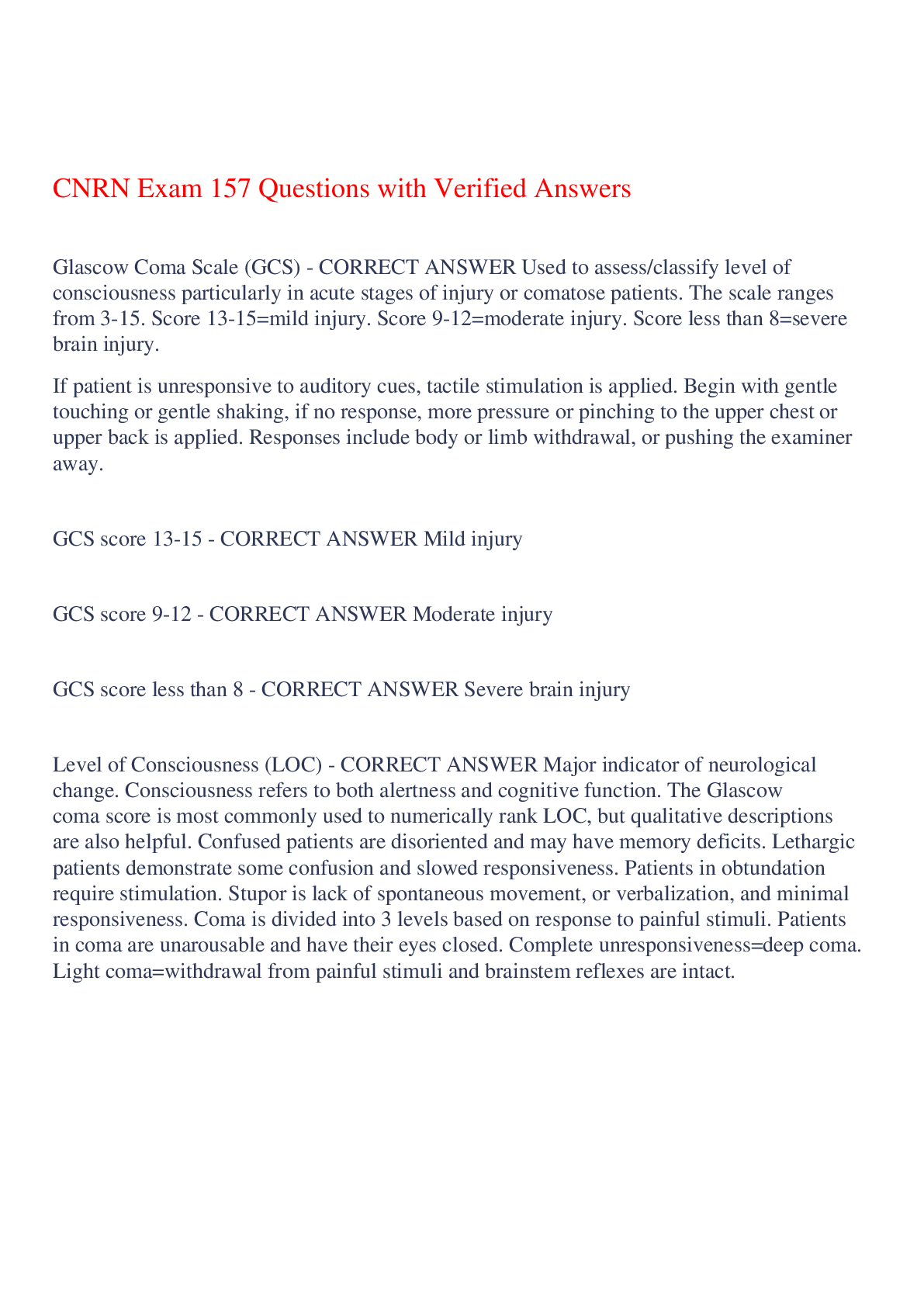
Buy this document to get the full access instantly
Instant Download Access after purchase
Add to cartInstant download
Reviews( 0 )
Document information
Connected school, study & course
About the document
Uploaded On
Oct 24, 2023
Number of pages
20
Written in
Additional information
This document has been written for:
Uploaded
Oct 24, 2023
Downloads
0
Views
42














.png)
